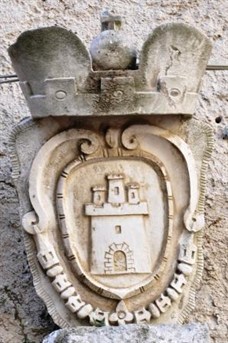The d’Avalos family
 The d’Avalos family, of Castilian origin, moved to the Kingdom of Naples as a result of Alfonso of AragonAlfonso of Trastámara called the Magnanimous (1394-1458), was the Count of Barcelona and the Catalan counties, the King of Aragon, Valencia, Majorca, Sardinia, Sicily, Jerusalem, Hungary and, from 1442, King of Naples with the name of Alfonso I. After conquering the Kingdom of Naples, he established his court in the capital city of Naples, transforming it into the centerpiece of the Crown of Aragon. in the middle of the fifteenth century, with Inigo (or Innico) d’Avalos and his three sons, Alfonso, Rodrigo and Innico Junior, becoming one of the major families of the Kingdom. Valiant captains and men-at-arms, they distinguished themselves on the main fronts of the war, without neglecting the life of court and the administration and diplomacy. Joining Neapolitan patricians through the Seggio di NidoThe Neapolitan nobility was divided into the five squares of quarters or seats in the civil parliament during the early modern age: Capuana, Montagna, Nido, Portanova and Porto. The representatives of the five squares together with a representative of the people, formed the Tribunale di San Lorenzo (Tribunal of St. Lawrence), which ruled the city., a seat at the municipal parliament, they had numerous fiefs and the privilege of coining money and naming counts. Joining some of the most aristocratic families of the kingdom, their residences were characterized as centres of artistic and cultural promotion and as real courts, where the presence of artists and men of culture was substantial.
The d’Avalos family, of Castilian origin, moved to the Kingdom of Naples as a result of Alfonso of AragonAlfonso of Trastámara called the Magnanimous (1394-1458), was the Count of Barcelona and the Catalan counties, the King of Aragon, Valencia, Majorca, Sardinia, Sicily, Jerusalem, Hungary and, from 1442, King of Naples with the name of Alfonso I. After conquering the Kingdom of Naples, he established his court in the capital city of Naples, transforming it into the centerpiece of the Crown of Aragon. in the middle of the fifteenth century, with Inigo (or Innico) d’Avalos and his three sons, Alfonso, Rodrigo and Innico Junior, becoming one of the major families of the Kingdom. Valiant captains and men-at-arms, they distinguished themselves on the main fronts of the war, without neglecting the life of court and the administration and diplomacy. Joining Neapolitan patricians through the Seggio di NidoThe Neapolitan nobility was divided into the five squares of quarters or seats in the civil parliament during the early modern age: Capuana, Montagna, Nido, Portanova and Porto. The representatives of the five squares together with a representative of the people, formed the Tribunale di San Lorenzo (Tribunal of St. Lawrence), which ruled the city., a seat at the municipal parliament, they had numerous fiefs and the privilege of coining money and naming counts. Joining some of the most aristocratic families of the kingdom, their residences were characterized as centres of artistic and cultural promotion and as real courts, where the presence of artists and men of culture was substantial.
The itinerary proposed here runs between Abruzzo, Molise and Campania, where the d’Avalos had their most significant residences. The Marquisade of Vasto, in Abruzzo, was the most important fief of the d’Avalos, a real court which remained in existence until the early decades of the eighteenth century. But even in Campania, in addition to the residences in Naples, the d’Avalos owned dwellings of considerable value, first in Ischia and Procida, where the presence of the powerful family had a positive impact on the artistic, cultural and urban development of the territory. The sea and the gardens, as we shall see, were an essential element in the identification and renovation of several buildings which the D’Avalos had built or restored.
The route passes through places and areas which are rich in history with artistic, architectural, archaeological heritage also in natural scenery of great charm and beauty.
